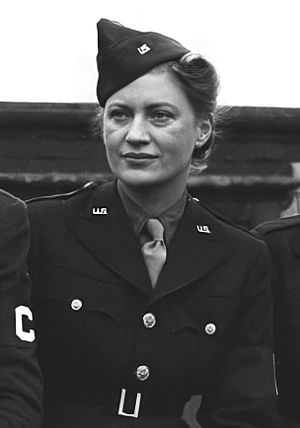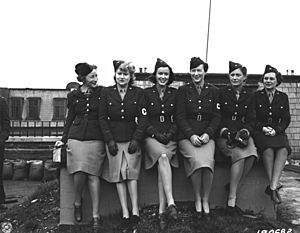Lee Miller facts for kids
Quick facts for kids
Lee Miller
|
|
|---|---|
 |
|
| Born |
Elizabeth Miller
April 23, 1907 Poughkeepsie, New York, U.S.
|
| Died | July 21, 1977 (aged 70) Chiddingly, East Sussex, U.K.
|
| Known for | Photojournalism |
| Movement | Surrealism |
| Spouse(s) |
Aziz Eloui Bey
(m. 1934; div. 1947) |
| Signature | |
Elizabeth "Lee" Miller, Lady Penrose (born April 23, 1907 – died July 21, 1977) was an American photographer and photojournalist. She started as a fashion model in New York City in the 1920s. Later, she moved to Paris and became a fashion and fine art photographer. During World War II, she worked as a war correspondent for Vogue. She covered important events like the London Blitz and the liberation of Paris. She also documented the terrible conditions in concentration camps like Buchenwald and Dachau.
Early Life and Education
Lee Miller was born on April 23, 1907, in Poughkeepsie, New York. Her parents were Theodore and Florence Miller. Her father, Theodore, loved photography and often used Lee as a model. He taught her a lot about how cameras work.
Lee had some trouble with school and was often expelled. When she was 18, in 1925, she moved to Paris. There, she studied lighting and design for theater. She returned to New York in 1926 and later studied art in Manhattan.
Career Highlights
Becoming a Model
Lee Miller's career began unexpectedly. When she was 19, she almost got hit by a car in Manhattan. Luckily, Condé Montrose Nast, the publisher of Vogue magazine, saved her. This meeting led to her becoming a model.
She appeared on the cover of Vogue in March 1927. For the next two years, she was a very popular model. She was photographed by famous artists like Edward Steichen. However, her modeling career ended when a company used her photo without her permission for an advertisement.
Starting Photography
In 1929, Miller went to Paris to work with surrealist artist and photographer Man Ray. Even though he didn't usually take students, Lee became his assistant and artistic partner. She even took over some of his fashion photography jobs.
Together, they rediscovered a photography technique called solarisation. This technique makes parts of a photo look both positive and negative at the same time. It was a perfect fit for Surrealism, an art movement that explored dreams and unexpected ideas.
Lee Miller became friends with other famous artists like Pablo Picasso and Jean Cocteau. Cocteau was so impressed by her that he featured her in his film, The Blood of a Poet (1930).
After leaving Paris in 1932, Lee Miller opened her own photography studio in New York City. She took portraits and commercial photos for many big companies. Her work was shown in important art exhibitions, including one at the Brooklyn Museum. In 1933, she had her only solo exhibition at the Julien Levy Gallery.
In 1934, Lee married Egyptian businessman Aziz Eloui Bey and moved to Egypt. While she didn't work professionally, she took many striking photos there. These photos, like Portrait of Space, are considered important surrealist works.
By 1937, she returned to Paris and met British surrealist painter Roland Penrose. Her photographs were shown in exhibitions in London and at the Museum of Modern Art (MoMA) in New York.
Documenting World War II
When World War II began, Lee Miller was living in London. She decided to stay and become a photojournalist for Vogue magazine. She documented the bombing of London, known as the Blitz. In 1942, she became an official war correspondent for the U.S. Army.
Miller took photos of nurses and soldiers across Europe. She worked with American photographer David E. Scherman. She traveled to France after D-Day and photographed the liberation of Paris. She also bravely documented the horrors of the Nazi concentration camps at Buchenwald and Dachau.
One of her most famous photos shows her in the bathtub of Adolf Hitler's apartment in Munich. This picture showed her defiance and her presence at the end of the war. Lee Miller's goal was to show the world what was happening during the war. Her photos helped people understand the terrible events she witnessed.
Life After the War
After the war, Lee Miller returned to Britain. She struggled with the difficult things she had seen during the war. She continued to work for Vogue for a few more years, covering fashion and celebrities.
In 1947, she married Roland Penrose, and their son, Antony Penrose, was born. In 1949, they bought Farley Farm House in East Sussex. Their home became a meeting place for many famous artists, including Picasso and Man Ray. Lee Miller also became a talented cook, creating unique dishes.
Lee Miller passed away from cancer at Farley Farm House in 1977, at the age of 70.
Legacy and Impact
Lee Miller didn't promote her own photographic work much during her lifetime. Her amazing work is known today mostly because of her son, Antony Penrose. After her death, he found thousands of her photographs, negatives, and journals in their attic. He has worked hard to preserve and share his mother's art.
Antony Penrose published the first book about his mother, The Lives of Lee Miller, in 1985. Since then, many other books and exhibitions have showcased her photographs. Her work has inspired fashion designers and artists.
Lee Miller believed that photography was a great profession for women. She said women were "quicker and more adaptable than men" and had an "intuition that helps them understand personalities more quickly." Her powerful and unique photographs continue to shock and inspire people today.
Images for kids
Error: no page names specified (help). In Spanish: Lee Miller para niños
In Spanish: Lee Miller para niños


